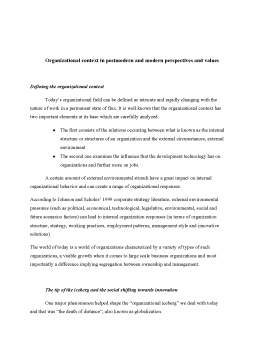Extras din referat
Organizational context in postmodern and modern perspectives and values
Defining the organizational context
Today’s organizational field can be defined as intricate and rapidly changing with the nature of work in a permanent state of flux. It is well known that the organizational context has two important elements at its base which are carefully analyzed:
- The first consists of the relations occurring between what is known as the internal structure or structures of an organization and the external circumstances, external environment
- The second one examines the influence that the development technology has on organizations and further more on jobs.
A certain amount of external environmental stimuli have a great impact on internal organizational behavior and can create a range of organizational responses.
According to Johnson and Scholes’ 1999 corporate strategy literature, external environmental pressures (such as political, economical, technological, legislative, environmental, social and future scenarios factors) can lead to internal organization responses (in terms of organization structure, strategy, working practices, employment patterns, management style and innovative solutions)
The world of today is a world of organizations characterized by a variety of types of such organizations, a visible growth when it comes to large scale business organizations and most importantly a difference implying segregation between ownership and management.
The tip of the iceberg and the social shifting towards innovation
One major phenomenon helped shape the “organizational iceberg” we deal with today and that was “the death of distance”, also known as globalization.
“Globalization means the intensification of worldwide social relations which link distant localities in such a way that local happenings are shaped by events occurring many miles away and vice versa.” Meaning geographical, territorial isolation, division falls out of use, no longer applies when it comes to distant countries and individuals. This breaks through any idea of boundary, making exchanges of ideas and information more prompt than ever before. Free trade has helped with the easier movement of money, goods and services around the world, while giving more importance and decision making powers to higher supranational bodies, such as the EU (European Union) or NAFTA (North American Free Trade Agreement), ASEAN (Association of South East Asian Nations) and so on.
In this sense, John Kotter, in 1995, argues that four main trends led to a series of organizational adaptation and change:
1. Technological innovation made communication faster and easier than ever, which led to global information networks and quicker transports.
2. International trade meant freer trade and capital flows at global level and less barriers when it came to tariffs.
3. Mature markets brought the threat of imports, a degree of privatization and deregulation and a rate of slower growth in advanced economies.
4. End of “Cold War” made possible an overwhelming privatization of the state sector, also it made more and more countries embrace the capitalist market system.
The main causal chain reaction led to globalization which implied a higher degree of danger, speed and more competition. On the positive side it also involved more opportunities with new markets and fewer barriers to trade and tariffs. This eventually resulted in organizational adaptation and change entailing:
- reduction in number and significance of traditional working class
- increased female participation in workforce
- decline of manufacturing, growth of services
- growth in number and significance of “knowledge workers”
Preview document
Conținut arhivă zip
- Organizational Behaviour.docx



























